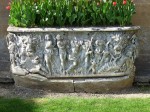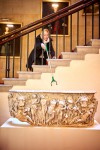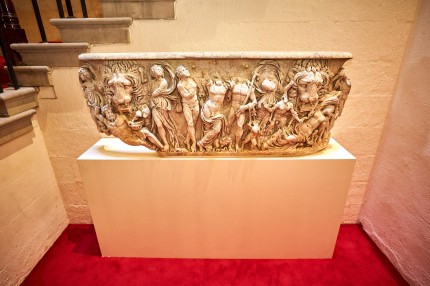 A 1,700-year-old Roman sarcophagus has been discovered on the grounds of Blenheim Palace where it was being used as a flowerpot. An antiques expert who was visiting the estate on other business spotted the beautifully carved bas-relief on a planter filled with soil and tulips and bolted to a lead cistern. He recognized the carving as a Dionysian scene likely of ancient Roman origin and remembered a previous sale of a garden planter that turned out to be a Roman sarcophagus, because it seems estate appraisers in England glean sarcophagi in the hedgerows
A 1,700-year-old Roman sarcophagus has been discovered on the grounds of Blenheim Palace where it was being used as a flowerpot. An antiques expert who was visiting the estate on other business spotted the beautifully carved bas-relief on a planter filled with soil and tulips and bolted to a lead cistern. He recognized the carving as a Dionysian scene likely of ancient Roman origin and remembered a previous sale of a garden planter that turned out to be a Roman sarcophagus, because it seems estate appraisers in England glean sarcophagi in the hedgerows
 He brought it to the attention of palace staff who determined it was the front of a white marble sarcophagus carved around 300 A.D. The quality of the carving is extremely high. An inebriated Dionysus is supported by a satyr and surrounded by his drunken followers, including the demigod Hercules and Ariadne, who saved Theseus from the Labyrinth and Minotaur only to be abandoned by him after a night of revelry with Dionysus on the island of Naxos. Close to the edges of the scene are two large lion heads facing outward.
He brought it to the attention of palace staff who determined it was the front of a white marble sarcophagus carved around 300 A.D. The quality of the carving is extremely high. An inebriated Dionysus is supported by a satyr and surrounded by his drunken followers, including the demigod Hercules and Ariadne, who saved Theseus from the Labyrinth and Minotaur only to be abandoned by him after a night of revelry with Dionysus on the island of Naxos. Close to the edges of the scene are two large lion heads facing outward.
 While there are no records in the Blenheim archives to pinpoint when the artifact entered the palace collection, experts believe it was acquired in the 19th century by George Spencer-Churchill, the 5th Duke of Marlborough and great-great grandfather of Sir Winston Churchill. The duke was an avid collector of art and antiquities, much of which would eventually be sold to pay off his many, many creditors. Installed as a basin to collect water from a natural spring near the estate’s Great Lake, the sarcophagus managed to survive the great sell-off. In the early 20th century it was moved to a rock garden. That’s where it stayed for a century until its recent rescue from tulipmania.
While there are no records in the Blenheim archives to pinpoint when the artifact entered the palace collection, experts believe it was acquired in the 19th century by George Spencer-Churchill, the 5th Duke of Marlborough and great-great grandfather of Sir Winston Churchill. The duke was an avid collector of art and antiquities, much of which would eventually be sold to pay off his many, many creditors. Installed as a basin to collect water from a natural spring near the estate’s Great Lake, the sarcophagus managed to survive the great sell-off. In the early 20th century it was moved to a rock garden. That’s where it stayed for a century until its recent rescue from tulipmania.
It’s the Grand Tour that started all this in the 18th century. When the sons of wealthy families returned from their post-university voyages through France, Italy and the other history-rich countries of continental Europe, they were laden with art and antiquities they’d collected along the way. Sarcophagi were a popular choice, the larger and more elaborately carved the better. Their shapes made them convenient receptacles and using an ancient sarcophagus as a garden planter became fashionable in upper class households. By the second half of the 19th century, replicas of classical-style urns and sarcophagi were found in gardens all over Britain. To this day antique forms remain popular planters.
 The Blenheim Palace planter is 6’6″ long, but the front panel with the relief is the only part remaining of the original Roman sarcophagus. The base, sides and back are missing, replaced with stone stand-ins that allowed the carved fragment to be seen in a facsimile of its original context. Just by itself, the fragment is six feet long, 2.5 feet high, six inches thick and weighs 550 pounds.
The Blenheim Palace planter is 6’6″ long, but the front panel with the relief is the only part remaining of the original Roman sarcophagus. The base, sides and back are missing, replaced with stone stand-ins that allowed the carved fragment to be seen in a facsimile of its original context. Just by itself, the fragment is six feet long, 2.5 feet high, six inches thick and weighs 550 pounds.
 The palace called Nicholas Banfield of Cliveden Conservation to remove the ancient piece and transport it to their lab for cleaning and conservation. They cut the bolts connecting the planter to the cistern, liberating it from its prison. The marble surface was cleaned with nothing but water and soft wooden picks to chip away at the calcified crust left by more than a century of use as a water feature. The restoration took
The palace called Nicholas Banfield of Cliveden Conservation to remove the ancient piece and transport it to their lab for cleaning and conservation. They cut the bolts connecting the planter to the cistern, liberating it from its prison. The marble surface was cleaned with nothing but water and soft wooden picks to chip away at the calcified crust left by more than a century of use as a water feature. The restoration took  six months and now the sarcophagus fragment has gone on display inside the palace.
six months and now the sarcophagus fragment has gone on display inside the palace.
“We are delighted to have it back and the restoration work undertaken by Nicholas is very impressive. Now it is in a consistent indoor climate away from the natural elements we are hoping it will remain in good condition and survive for many more centuries to come,” said Kate Ballenger, House Manager at Blenheim Palace.
